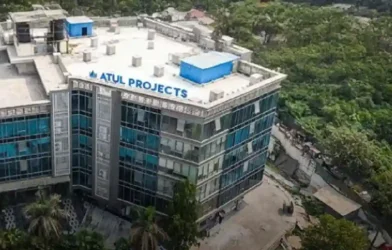Subtotal ₹0.00
– Mayank Pathak, Managing Director, Translate Formwork and Scaffolding
In construction, safety and efficiency are the foundation of every successful project. Scaffolding has always been essential, providing workers with access to hard-to-reach areas and ensuring stability during complex construction projects. However, traditional scaffolding often presents challenges, including time-consuming assembly, heavy labour requirements, and potential safety risks. As construction demands have become more complex, there has been a clear shift toward more innovative and adaptable systems that simplify work without compromising strength or security.
This is where modular scaffolding systems have changed the game. They bring a new level of design precision, ease of use, and reliability to modern projects. Built with standardized components that fit together seamlessly, modular scaffolds enable construction teams to work faster and more safely. The following sections examine how these systems enhance performance, mitigate risks, and transform the way construction sites operate globally.
The Evolution of Scaffolding
Scaffolding has evolved from basic wooden structures to advanced engineered systems. In the past, traditional tube-and-coupler scaffolds dominated worksites. While effective, they required manual fitting and careful alignment, leaving room for error and inconsistency. These systems were sturdy but slow to assemble, often increasing project timelines.
The introduction of modular scaffolding completely changed this landscape. With prefabricated, interlocking parts, modular systems ensure uniformity and reduce the dependency on manual adjustments. Each piece connects securely, making the structure stable and easy to build. This shift has enabled construction companies to complete work more efficiently, maintain higher safety standards, and lower overall costs.
What Makes Modular Scaffolding Different
Modular scaffolding is built around the idea of simplicity and precision. Each component—such as vertical posts, ledgers, and braces—is manufactured to exact specifications. Instead of using clamps or bolts, these parts lock into place with specially designed connectors that guarantee accuracy.
This design reduces assembly time and limits the chance of errors. Workers can set up and dismantle the scaffolding quickly using minimal tools. The consistent structure also ensures that the system can bear heavy loads safely, making it suitable for a wide range of projects, from small residential jobs to large industrial or infrastructure developments.
Safety Through Design
Safety is always the top priority in construction, and modular scaffolding directly supports this goal. Traditional scaffolds rely heavily on skilled labour to ensure alignment and stability. In contrast, modular scaffolds come with pre-engineered locking systems that ensure every joint is secure. This design eliminates weak points and distributes weight evenly, preventing collapses or instability.
Features like non-slip decks, built-in guardrails, and safe access points further enhance worker protection. Many modular systems are also tested to international safety standards, providing builders with confidence that they meet strict compliance requirements. By reducing risks and improving consistency, modular scaffolding helps create safer worksites and fewer accidents.
Time and Labour Efficiency
One of the primary reasons modular scaffolding has gained popularity is its impact on time management. Unlike traditional systems that take several days to set up, modular scaffolds can be assembled much faster. Their standardized design allows workers to complete installations quickly, even with smaller teams.
This time saving translates directly into cost savings. With shorter setup and dismantling periods, construction teams can focus more on the actual building work rather than logistics. For large projects with strict deadlines, modular scaffolding can make the difference between finishing on schedule and falling behind.
Versatility Across Applications
Another major strength of modular scaffolding is its adaptability. The system can be adjusted to suit different project types and site conditions. Whether the job involves a high-rise building, bridge repair, or industrial plant maintenance, modular scaffolding can be customized to fit the exact layout.
Due to its flexibility, the same system can be reused across multiple projects. This makes it a wise long-term investment. Many construction companies also use modular scaffolding beyond building sites, such as for event staging or ship maintenance. Its ability to adapt to different structures adds real value to every project.
Cost Benefits Over Time
While modular scaffolding may initially cost more, its long-term benefits easily outweigh the upfront expense. The durability of materials such as steel or aluminum means these systems last for years with minimal maintenance. They are also designed for repeated use, which significantly reduces replacement costs.
The faster assembly and enhanced safety reduce labour expenses and downtime. Fewer accidents mean fewer disruptions and lower insurance costs. When viewed across multiple projects, modular scaffolding proves to be an economical choice that delivers consistent value.
Supporting Sustainable Construction
Sustainability is becoming a priority for the global construction industry. Modular scaffolding supports this movement by reducing waste and promoting resource efficiency. Since its parts are reusable and recyclable, fewer raw materials are consumed over time.
The quicker installation process also helps lower energy consumption and emissions from machinery used on-site. This makes modular scaffolding a responsible choice for companies looking to meet environmental standards while maintaining operational efficiency. It is an example of how innovation can support both business goals and environmental responsibility.
Technology and Continuous Improvement
Modern modular scaffolding benefits from precise manufacturing and design technologies. Many systems are created using advanced computer modeling to test load capacity, stress points, and alignment accuracy before production. Some companies are also introducing tracking tools that allow site managers to monitor usage, maintenance, and component movement.
These improvements not only enhance performance but also ensure that scaffolding remains in top condition across multiple projects. As technology continues to evolve, we can expect modular systems to become even more innovative and more efficient, with features that further improve safety and site coordination.
The Future of Construction
As cities expand and infrastructure projects grow more ambitious, modular scaffolding will continue to play a vital role. Its ability to combine safety, flexibility, and speed makes it an essential tool for the next generation of construction practices. Builders today want systems that help them to adapt quickly without compromising quality, and modular scaffolding provides precisely that.
In the future, the integration of robotics or automated assembly may make scaffolding even more efficient. However, the core principles will remain the same—strong, simple, and safe structures that support human skill and innovation.














